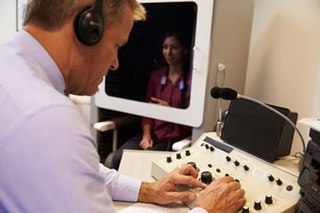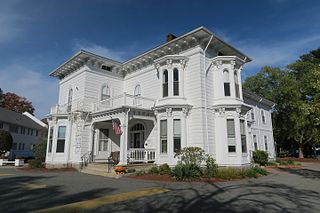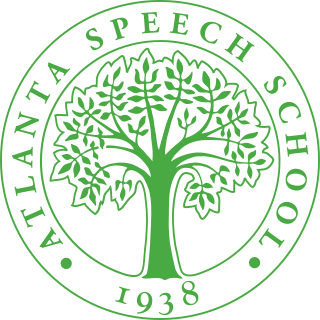Related Research Articles
CSD may refer to:

Audiology is a branch of science that studies hearing, balance, and related disorders. Audiologists treat those with hearing loss and proactively prevent related damage. By employing various testing strategies, audiologists aim to determine whether someone has normal sensitivity to sounds. If hearing loss is identified, audiologists determine which portions of hearing are affected, to what degree, and where the lesion causing the hearing loss is found. If an audiologist determines that a hearing loss or vestibular abnormality is present, they will provide recommendations for interventions or rehabilitation.
A communicative disorders assistant (CDA) performs hearing and speech-language screenings, prepares therapy materials, implements speech therapy, reports on therapy outcomes, performs routine maintenance on clinical equipment, and works with speech-language pathologists (SLPs) and audiologists to adjust therapy goals. While CDAs cannot perform assessments or set therapy goals, they are a vital part of the therapy team. CDAs are supervised by and work in conjunction with SLPs and audiologists.

A video relay service (VRS), also sometimes known as a video interpreting service (VIS), is a video telecommunication service that allows deaf, hard-of-hearing, and speech-impaired (D-HOH-SI) individuals to communicate over video telephones and similar technologies with hearing people in real-time, via a sign language interpreter.

The Learning Center for the Deaf (TLC) is a Framingham, Massachusetts-based non-profit organization and school serving deaf and hard-of-hearing children and adults. The mission of The Learning Center for the Deaf is to ensure that all deaf and hard of hearing children and adults thrive by having the knowledge, opportunity and power to design the future of their choice.

The Atlanta Speech School is a language and literacy school located in Atlanta, Georgia, established in 1938. The school provides educational and clinical programs. The Atlanta Speech School's Rollins Center provides professional development for teachers and educators in partner schools and preschools. The Rollins Center focuses on the eradication of illiteracy. The Rollins Center has an online presence called Cox Campus, which is an online learning environment with coursework targeted for the education of children age 0–8.
Singapore Sign Language, or SgSL, is the native sign language used by the deaf and hard of hearing in Singapore, developed over six decades since the setting up of the first school for the Deaf in 1954. Since Singapore's independence in 1965, the Singapore deaf community has had to adapt to many linguistic changes. Today, the local deaf community recognises Singapore Sign Language (SgSL) as a reflection of Singapore's diverse culture. SgSL is influenced by Shanghainese Sign Language (SSL), American Sign Language (ASL), Signing Exact English (SEE-II) and locally developed signs.
Aural rehabilitation is the process of identifying and diagnosing a hearing loss, providing different types of therapies to clients who are hard of hearing, and implementing different amplification devices to aid the client's hearing abilities. Aural rehab includes specific procedures in which each therapy and amplification device has as its goal the habilitation or rehabilitation of persons to overcome the handicap (disability) caused by a hearing impairment or deafness.

Deaf education is the education of students with any degree of hearing loss or deafness. This may involve, but does not always, individually-planned, systematically-monitored teaching methods, adaptive materials, accessible settings, and other interventions designed to help students achieve a higher level of self-sufficiency and success in the school and community than they would achieve with a typical classroom education. There are different language modalities used in educational setting where students get varied communication methods. A number of countries focus on training teachers to teach deaf students with a variety of approaches and have organizations to aid deaf students.
Speech and language impairment are basic categories that might be drawn in issues of communication involve hearing, speech, language, and fluency.
Speech-Language & Audiology Canada (SAC), formerly known as the Canadian Association of Speech-Language Pathologists and Audiologists (CASLPA), is a national organization supporting and representing speech-language pathologists, audiologists and communication health assistants. The association adopted its new name and logo on February 5, 2014.
Canadian Hearing Services was founded in 1940 to provide services for deaf and hard of hearing people in Ontario. Services include instruction in American and Quebec sign languages, interpreter services, deafblind intervenors, audiology and speech–language pathology. The CHS advocates for the hearing impaired in Canada through the support of 9-1-1 texting, visual fire alarms, and access to the justice system. The CHS handles emergency situations in hospitals, emergency rooms, after-hours clinics, shelters, and police services.

The National Institute of Speech and Hearing (NISH) is an institute devoted to the education and rehabilitation of individuals with speech-language and hearing impairments located in Thiruvananthapuram, the capital city in the Indian state of Kerala. It was established in 1997 on the initiative of the state of Kerala and is a self-financing affiliate college of the University of Kerala. Academics at NISH is unique in the sense that NISH has an integrated campus where students with hearing impairment and students with normal hearing share the same campus. Bachelor's level courses exclusively for students with hearing impairment include Degree courses in Fine Arts, Computer Science and Commerce affiliated to University of Kerala. On the other hand, NISH also provides RCI approved professional courses at undergraduate level and graduate level in Audiology and Speech Language Pathology as well as diploma courses affiliated to Kerala Health University (KUHS)
Deafness has varying definitions in cultural and medical contexts. In medical contexts, the meaning of deafness is hearing loss that precludes a person from understanding spoken language, an audiological condition. In this context it is written with a lower case d. It later came to be used in a cultural context to refer to those who primarily communicate through sign language regardless of hearing ability, often capitalized as Deaf and referred to as "big D Deaf" in speech and sign. The two definitions overlap but are not identical, as hearing loss includes cases that are not severe enough to impact spoken language comprehension, while cultural Deafness includes hearing people who use sign language, such as children of deaf adults.
Language deprivation in deaf and hard-of-hearing children is a delay in language development that occurs when sufficient exposure to language, spoken or signed, is not provided in the first few years of a deaf or hard of hearing child's life, often called the critical or sensitive period. Early intervention, parental involvement, and other resources all work to prevent language deprivation. Children who experience limited access to language—spoken or signed—may not develop the necessary skills to successfully assimilate into the academic learning environment. There are various educational approaches for teaching deaf and hard of hearing individuals. Decisions about language instruction is dependent upon a number of factors including extent of hearing loss, availability of programs, and family dynamics.
ASL interpreting is the real-time translation between American Sign Language (ASL) and another language to allow communication between parties who do not share functional use of either language. Domains of practice include medical/mental health, legal, educational/vocational training, worship, and business settings. Interpretation may be performed consecutively, simultaneously or a combination of the two, by an individual, pair, or team of interpreters who employ various interpreting strategies. ASL interpretation has been overseen by the Registry of Interpreters for the Deaf since 1964.
The Language Equality and Acquisition for Deaf Kids (LEAD-K) campaign is a grassroots organization. Its mission is to work towards kindergarten readiness for deaf and hard-of-hearing children by promoting access to both American Sign Language (ASL) and English. LEAD-K defines kindergarten readiness as perceptive and expressive proficiency in language by the age of five. Deaf and hard-of-hearing children are at high risk of being cut off from language, language deprivation, which can have far-reaching consequences in many areas of development. There are a variety of methods to expose Deaf and hard-of-hearing children to language, including hearing aids, cochlear implants, sign language, and speech and language interventions such as auditory/verbal therapy and Listening and Spoken Language therapy. The LEAD-K initiative was established in response to perceived high rates of delayed language acquisition or language deprivation displayed among that demographic, leading to low proficiency in English skills later in life.
There are about 357,000 deaf and 3,210,000 hard-of-hearing people in Canada. The country can be split into Francophone and Anglophone regions, and has both French and English as official languages. The majority of Canada is considered Anglophone, while the province of Quebec along with small parts of New Brunswick, Ontario, and Manitoba are primarily French-speaking. The presence of these two main languages and cultures also brings forth different deaf cultures between the two regions. In Francophone regions, the official language used by deaf and hard-of-hearing people is Quebec Sign Language.
The Democratic Republic of the Congo has a population of about 1.4 million deaf people out of a total population of about 86.7 million. The World Health Organization (WHO) claims that countries in Sub-Saharan Africa are one of the more greatly affected regions by hard-of-hearing complications, compared to the rest of the world. Deaf people in the DRC are subject to neglect and discrimination by their families and the government, but they are also met with small, various ways of support and charity through international, European, Australian, and American religious, non-religious, and governmental organizations.

The Windward Islands are a group of islands in the Caribbean Sea that include Dominica, Martinique, Barbados, Saint Lucia, Saint Vincent and the Grenadines, Trinidad and Tobago, and Grenada. A variety of cultures, beliefs, languages, and views of deafness exist on the islands.
References
- 1 2 3 4 5 6 7 Machen, Mary Gresham (1968). The Baltimore Hearing Society - A Survey of the Past – via The Internet Archive.
- ↑ Freedman, Allie (August 14, 2014). "New and Notable in Baltimore". Baltimore Jewish Times.
- ↑ Rotatori, Anthony F.; Obiakor, Festus E.; Bakken, Jeffrey B., eds. (2011). Advances in Special Education. Vol. 21. Emerald Group Publishing.
- ↑ "Interpreting & Communication Access Services". Governors Office of the Deaf and Hard of Hearing. 20 November 2016.
- ↑ Dorsett, Anne L (November 1927). "The President's Report". League News: Speech Reader's League of Baltimore 1. p. 2.
In June our League was made a member of the A.F.O.H.H. and two representatives were sent to the annual Federation Conference held at Chatauqua, New York.
- ↑ Ward, Anne D. (July 1936). "Committee on Membership". The Baltimore Council of Social Agencies. p. 16.
The Board of the Council of Social Agencies recommends to the Community Fund that admission of the League to membership in the Community Fund be deferred for the present...
- ↑ Ward, Anne D. (May 1936). "Committee on Membership". The Baltimore Council of Social Agencies. p. 16.
[I]t is the Council's opinion that from the point of view of the field of work in which the League operates as well as from the point of view of its present standards of performance the League is qualified for membership in the Community Fund...
- ↑ "Hearing Society Opens New Speech Clinic". The Evening Sun. Baltimore. August 11, 1960 – via The Internet Archive.
- 1 2 "Hearing and Speech Services: A study of services and activities in response to the communicative disorders". Health & Welfare Council of Baltimore Area, Inc. October 27, 1965 – via The Internet Archive.
- 1 2 "New Program to Offer Remote Access for ASL and Foreign Language Interp". PRWeb (Press release). November 16, 2012. Retrieved April 19, 2017.
- ↑ "State of Maryland 2006 Bond Bill Fact Sheet" (PDF). State of Maryland. 2006.
- 1 2 3 "2016 HASA Annual Report to the Community" (PDF). The Hearing and Speech Agency. 2016.
- ↑ "The Hearing and Speech Agency Hearing Aid Clinic in Baltimore, Maryland". HearingTracker.com. Archived from the original on April 20, 2017. Retrieved April 19, 2017.
{{cite web}}: CS1 maint: unfit URL (link) - ↑ Cohn, Meredith (January 26, 2017). "There are therapies when children don't outgrow stuttering". Baltimore Sun. Retrieved April 19, 2017.
- ↑ "Tips for hosting guests with sensory sensitivities". WMAR. December 12, 2016. Retrieved April 19, 2017.
- ↑ "Gateway School". The Maryland Association of Nonpublic Special Education Facilities. Retrieved April 19, 2017.